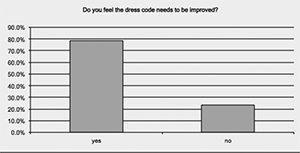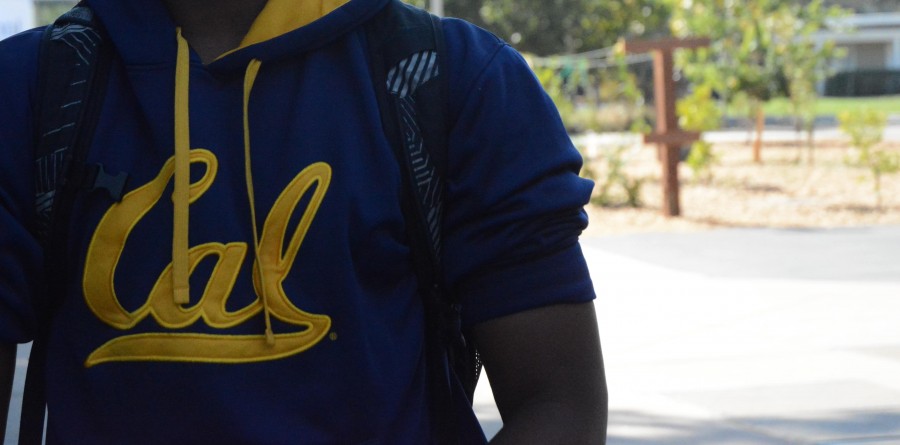Breaking the ice
Opening conversations on the dress code benefits the school.
The updated dress code policy permits logos larger than palm-size to be worn if the logo is rleated to Harker or a university.
Pocket-sized logos, no plain white shirts, fingertip length skirts. Concern over these and other additions to the dress code took center stage in the student-run Harker Summit on Sept. 25, in which students from all grades described their issues with the current standards set by the administration.

From the Summit, and the advisory discussions that followed a week later, it has become clear that the issue with the dress code was not its existence but its enforcement.
As students, we understand that having a set of rules outlining the way we should dress is important to conserving the off-campus image of the school. That’s not to say that Harker students are self-conscious to a fault, but most of us would concur that our school’s reputation matters.
Still, too often do we hear of students being stopped in the halls and given detentions for shirt designs that are too big or skirts that don’t follow the fingertip length rule. School records showed that 26 detentions related to the dress code have been assigned so far this year. Especially important is the logo rule, which has resulted in 20 of these detentions. Often these punishments are meted out in public, leaving students feeling embarrassed and stressed after being assigned to a detention.
For this reason, teachers and faculty need to open a discussion with students who are violating the dress code. This way a student knows when his or her attire is against the dress code but does not feel embarrassed. And to their credit, many teachers have chosen to pull students aside to talk about the issue.

Through conversation, the teacher has a chance to teach the values behind the dress code and to understand the student’s perspective on the rules. As some concerns recur, it’s up to the teachers to reveal the issues to the administration.
Ultimately, we students are the ones dressing up for school every day. If we don’t like the rules, there needs to be a reliable way to voice our concerns. Teachers might just be the best outlet for understanding and discussing the dress code.
But policing the halls does not fix the problem.
This piece was originally published in the pages of the Winged Post on Oct. 16, 2015.


















![“[Building nerf blasters] became this outlet of creativity for me that hasn't been matched by anything else. The process [of] making a build complete to your desire is such a painstakingly difficult process, but I've had to learn from [the skills needed from] soldering to proper painting. There's so many different options for everything, if you think about it, it exists. The best part is [that] if it doesn't exist, you can build it yourself," Ishaan Parate said.](https://harkeraquila.com/wp-content/uploads/2022/08/DSC_8149-900x604.jpg)




![“When I came into high school, I was ready to be a follower. But DECA was a game changer for me. It helped me overcome my fear of public speaking, and it's played such a major role in who I've become today. To be able to successfully lead a chapter of 150 students, an officer team and be one of the upperclassmen I once really admired is something I'm [really] proud of,” Anvitha Tummala ('21) said.](https://harkeraquila.com/wp-content/uploads/2021/07/Screen-Shot-2021-07-25-at-9.50.05-AM-900x594.png)







![“I think getting up in the morning and having a sense of purpose [is exciting]. I think without a certain amount of drive, life is kind of obsolete and mundane, and I think having that every single day is what makes each day unique and kind of makes life exciting,” Neymika Jain (12) said.](https://harkeraquila.com/wp-content/uploads/2017/06/Screen-Shot-2017-06-03-at-4.54.16-PM.png)








![“My slogan is ‘slow feet, don’t eat, and I’m hungry.’ You need to run fast to get where you are–you aren't going to get those championships if you aren't fast,” Angel Cervantes (12) said. “I want to do well in school on my tests and in track and win championships for my team. I live by that, [and] I can do that anywhere: in the classroom or on the field.”](https://harkeraquila.com/wp-content/uploads/2018/06/DSC5146-900x601.jpg)
![“[Volleyball has] taught me how to fall correctly, and another thing it taught is that you don’t have to be the best at something to be good at it. If you just hit the ball in a smart way, then it still scores points and you’re good at it. You could be a background player and still make a much bigger impact on the team than you would think,” Anya Gert (’20) said.](https://harkeraquila.com/wp-content/uploads/2020/06/AnnaGert_JinTuan_HoHPhotoEdited-600x900.jpeg)

![“I'm not nearly there yet, but [my confidence has] definitely been getting better since I was pretty shy and timid coming into Harker my freshman year. I know that there's a lot of people that are really confident in what they do, and I really admire them. Everyone's so driven and that has really pushed me to kind of try to find my own place in high school and be more confident,” Alyssa Huang (’20) said.](https://harkeraquila.com/wp-content/uploads/2020/06/AlyssaHuang_EmilyChen_HoHPhoto-900x749.jpeg)



